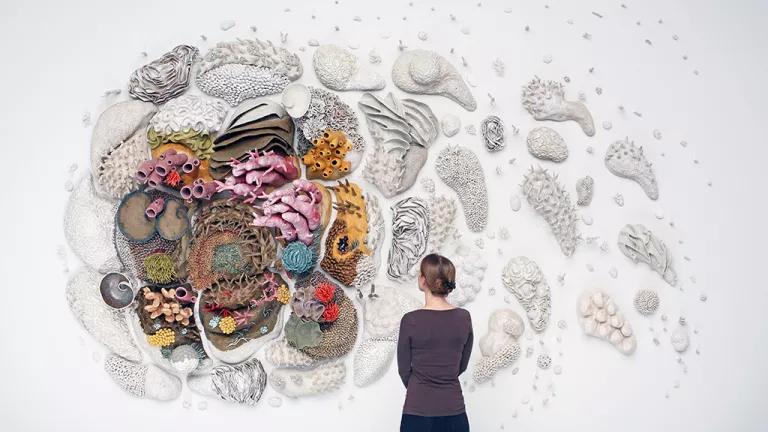Handle With Care
This artist’s handmade porcelain reefs are almost as fragile as the real thing.

Courtney Mattison’s large-scale ceramic coral reef installations are a labor of love. The artist-slash-ocean-advocate (Mattison likes to call herself an ocean “artivist”) shapes every branch and ridge of her porcelain colonies by hand, using chopsticks to poke thousands of holes for just the right texture and meditating on how the calcium carbonate found in the glaze is the same building block used by the polyps themselves. “I enjoy feeling like a coral,” Mattison writes in her artist statement, “patiently and methodically constructing large, delicate, stony structures that can change an ecosystem.”
Delicate is the adjective that Mattison most hopes viewers of her art will take with them. Her works, which have been exhibited at the headquarters of NOAA and the American Association for the Advancement of Science, are “inspired by the fragile beauty of coral reefs and the human-caused threats they face.” These pictures come from “Sea Change,” her new solo show currently on display at the Virginia Museum of Contemporary Art until April 17. The sprawling Our Changing Seas III, above, has a vibrantly colored center, but the outer fringes are the ghostly white of a bleached reef. Mattison understands all too well that the decisions we make about how to treat our Blue Planet could make or break her beloved corals.





This article was originally published on onEarth, which is no longer in publication. onEarth was founded in 1979 as the Amicus Journal, an independent magazine of thought and opinion on the environment. All opinions expressed are those of the authors and do not necessarily reflect the policies or positions of NRDC. This article is available for online republication by news media outlets or nonprofits under these conditions: The writer(s) must be credited with a byline; you must note prominently that the article was originally published by NRDC.org and link to the original; the article cannot be edited (beyond simple things such grammar); you can’t resell the article in any form or grant republishing rights to other outlets; you can’t republish our material wholesale or automatically—you need to select articles individually; you can’t republish the photos or graphics on our site without specific permission; you should drop us a note to let us know when you’ve used one of our articles.

How to Become a Community Scientist
Biodiversity 101
How to Start Saving the Planet in 100 Days: the Joe Biden Edition